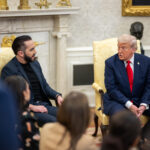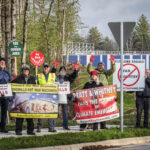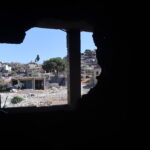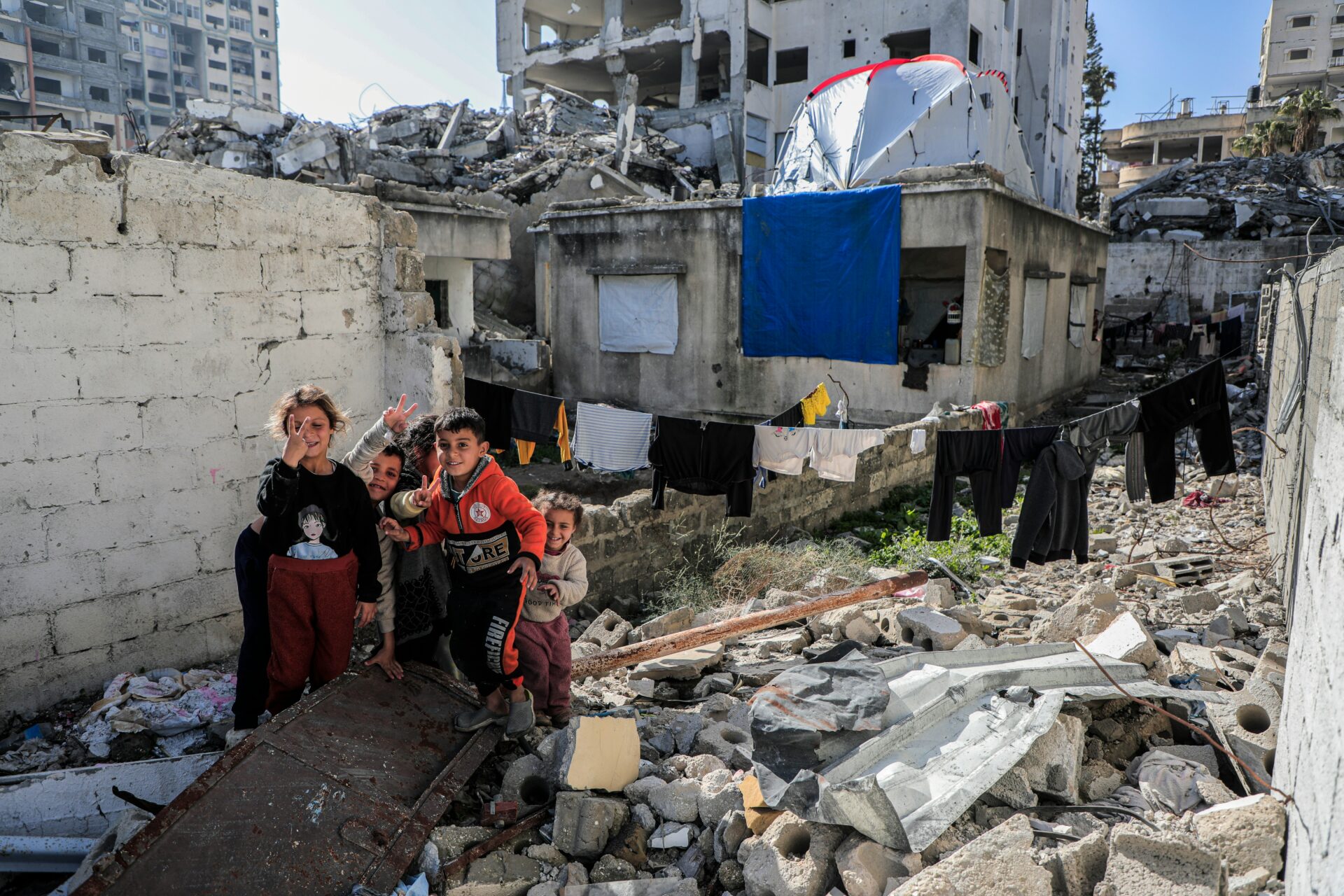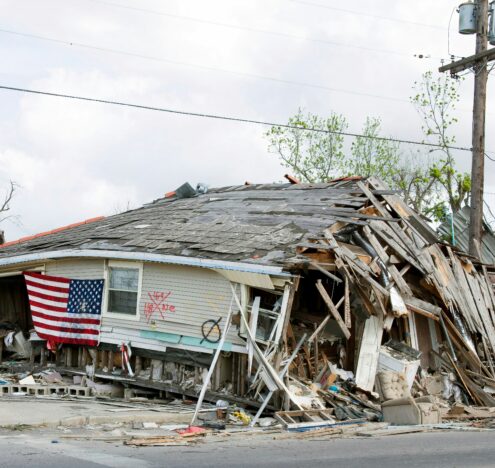In late February, Donald Trump took to Instagram to share a bizarre video, an artificial intelligence rendition of what the Gaza Strip would supposedly look like if the United States occupied it. After a few harrowing scenes of civilians and fighters rummaging through the recent destruction Israeli forces have inflicted on the coastal enclave, the video flashes to a series of rapid-fire clips: a gold statue of Trump, a child holding a golden balloon in the shape of Trump’s head, and an apparent hotel called “Trump Gaza.”
The video also features images of belly dancers, apparent Elon Musk cameos, poolside partying, children playfully tossing money into the air, and Trump and Israeli Prime Minister Benjamin Netanyahu (both shirtless) enjoying drinks on the beach. All the while, an equally unsettling song plays over the video. “Donald’s coming to set you free, bringing the light for all to see,” it starts. “No more tunnels, no more fear, Trump Gaza is finally here. Trump Gaza’s shining bright, golden future, a brand-new light, feast and dance, the deal is done, Trump Gaza number one.”
The video is the latest installment in the US president’s proposal to “take over” and “own” the Strip, a plan he first floated in early February. The way he put it, Palestinians would have to leave, abandon the option of returning, and ostensibly give up on the enclave, now fresh from Israel’s deadliest and most destructive of five wars on the Strip since late 2008.
That most recent war began on Oct. 7, 2023, after Hamas-led militants launched an attack on communities in the southern part of present-day Israel that killed hundreds. Israel, in turn, launched an assault that killed at least (though probably far more than) 48,000 people, destroyed more than 90% of the homes in the territory, and created north of 50 million tons of debris and rubble. Throughout the fighting, the Israeli government repeatedly balked at the Biden administration’s calls for it to allow more humanitarian aid into a population that was wracked with starvation and malnutrition — and save for a hollow gesture or two, the US let the money and weapons keep flowing to Netanyahu’s far-right government. Not long before President Joe Biden left office, his administration signed off on a deal to sell $8 billion in weapons to Israel, a boost that came after Washington had already provided some $17.9 billion in aid to the country since the beginning of the war.
From the start, Israel dubiously insisted that its primary objective was to eliminate Hamas, the political party that won Palestinian elections in 2006 and has reigned over Gaza ever since. When the US, Qatar, and Egypt brokered a ceasefire in January, Hamas’s armed wing, al-Qassam Brigades, was badly hurting but far from eliminated. That Trump imagines Palestinians would drop their right to a country, a concession they refused to make even as Israel waged its US-sponsored, 15-month war, is baffling.
*
I first moved to Israel and Palestine in 2011, a time when, implausible as it now seems, the western-backed Palestinian Authority was desperately seeking recognition of a state in the occupied West Bank, including East Jerusalem, and the Gaza Strip. In November 2012, Palestinian Authority President Mahmoud Abbas took his case to the United Nations General Assembly. Despite American and Israeli threats against the Palestinian leadership, 138 countries voted in favor of Palestine’s non-member state recognition. For weeks, I watched on as, throughout the streets of the West Bank, Palestinians rattled off fireworks and celebrated the achievement. Billboards applauding the “State of Palestine” came up on roads between Ramallah and other West Bank cities, and Abbas took a brief victory lap.
Yet, it soon became clear that the UN recognition would change little in the daily lives of the millions of Palestinians who lived in the West Bank and Gaza. Around half a million Israeli settlers still resided in fortified colonies across East Jerusalem and the rest of the West Bank, Israeli military bases still dotted the map of the territory, and Gaza remained in the grip of a suffocating Israeli-Egyptian blockade that began in 2007. And for its part, the Palestinian Authority maintained its much-despised security coordination with Israel, an agreement Abbas later described as “holy.”
Across the four years I worked as a reporter there — including the three years after the UN General Assembly’s recognition — I often traveled to the cities, villages, and refugee camps that suffered the worst under Israeli occupation. In Hebron, I met Marwa, a seven-year-old Palestinian girl who had her hair set on fire by Israeli settlers. At the nearby Fawwar refugee camp, I spoke with a six-year-old boy, Mousab, who lost an eye when an Israeli troop fired a rubber-coated steel bullet into his face. In el-Bireh, near Ramallah, I interviewed Ahmad Qatamesh, a Palestinian writer and intellectual who had already spent more than eight years in administrative detention. In Qatamesh’s words, that practice, in which Israel jails Palestinians on “secret evidence” and without charges, “is one of the most difficult of Israel’s tactics because prisoners have nothing but uncertainty.” (Now 75, Qatamesh has been arrested several times since I met him.)
Deep concern did little to stop the brutality.
Throughout the years leading up to the summer of 2014, I’d come to understand what Palestinians intrinsically knew: that the cruelest aspect of Israel’s military occupation was not the sudden flare-ups in violence but the grueling routine of checkpoints, raids, and arrests. Then, that July, Israel launched its third war on the Gaza Strip since December 2008, the longest and deadliest assault up until that point. As the airstrikes rained down, US President Barack Obama now and then let the world know he was “deeply concerned” about civilian deaths in Gaza, always stressing that Israel had a right to defend itself.
Deep concern did little to stop the brutality. When that war eventually ended in late August 2014, Israeli airstrikes and shelling had left the Strip, an area about the size of Philadelphia, in complete ruins. Worse yet, the fighting killed 2,251 Palestinians — more than two thirds of them were civilians, according to the UN — as well as 66 Israeli troops and five civilians in Israel. The Obama administration would go on to greenlight $38 billion in aid to Israel, the largest military assistance package to date.
*
At the tail end of 2014, I passed through Israel’s Erez Crossing and entered Gaza for the first time. As I walked from the Israeli checkpoint through a long, enclosed corridor that led to the Palestinian side, gunshots from automated turrets perched on the Israeli fence fired off now and then. Rubble bordered either side of the road, and once I got in a taxi, I watched through the window as families dug in the debris of what had once been their homes. Months had passed since a ceasefire went into effect, but people were still piecing together whatever was left of their lives.
That was my first trip of many to Gaza. On my next visit, in January 2015, I walked with a Palestinian colleague in the Shuja’iyya neighborhood of Gaza City. Destruction fanned out all around us. It didn’t take long to understand that, ceasefire or not, the war was still killing Palestinians: We met a family who, while sleeping in their bombed-out home, lost a five-month-old child to exposure on a cold winter night. Down the street, we stopped and took stock of a home that caught our attention. Only one wall was still half-standing, and on it someone had spray painted, “All this family killed by USA weapons.”
On another trip to Gaza in April 2015, little had changed. Rubble still lined the streets, towers that had once housed dozens of families were still piles of busted concrete and mangled steel, and thousands of displaced families were still sleeping in schools turned into makeshift shelters. Along with a Palestinian photographer, I rode in a taxi out to a house in Jabalia, not far from the eponymous refugee camp, and met a man named Issam Abu Mustafa Joudeh.

Joudeh wore slacks and a brown sweater over a neatly pressed button-up, grey flecked his otherwise dark beard, and he had the bookish looks of an academic. At 48 years old, he spoke with the measured calmness and warmth of someone who valued hospitality. After disappearing into his home for a few minutes, he reemerged with a kettle in hand, then poured each of us a cup of tea.
Like anyone who was six years or older in Gaza, he had survived three full-scale wars on the Palestinian enclave. He, his wife, and his children had toughed out Israel’s eight-day offensive in 2012, as well as the three-week war that started at the end of 2008. By the time summer 2014 war broke out, Joudeh and his wife had eight children, three of whom were grown and living with their own families elsewhere. Forty-nine days into that war, the Joudeh family seemed poised to outlast the violence once again.
By mid-August, talk of a permanent ceasefire began to trickle into the news each day. But that Aug. 24, two days before Israel and Hamas finally reached an agreement, loss came for the Joudeh family. Early that afternoon, Joudeh got ready to make lunch at their home. When he stepped inside, his wife and five of his children were still out in the backyard. He was speaking to them through an open window, asking how hungry they were and preparing their meals, when a deafening whirring sound cut him off. The house rumbled. A massive explosion came next.
Joudeh darted back outside. The first thing he saw, he told me, was the immense, still-smoking crater a missile had torn into the earth. Then, he spotted his loved ones strewn across the lawn, each of them drenched in blood. He’d later learn that Israel had fired the missile from a drone, but at that moment, he was still putting the pieces together. “I knew it was bad,” he told me, “that there was death.” As he rushed from one loved one to the next, his fears became reality. The drone strike had killed his wife and four of his children. One of Joudeh’s sons, Thaer, was still breathing, but just barely. The boy “was calling for me to help him,” he explained.
Two days later, Israel and the armed groups in Gaza reached a ceasefire. Joudeh’s wife was one of 299 Palestinian women killed that summer. His four slain children — six-year-old Osama, eight-year-old Mohammed, 12-year-old Raghad, and 14-year-old Tasneem — joined the 551 Palestinian children who died at the hands of Israeli missiles, gunfire, or shrapnel. Only Thaer survived, but after he was sent off to Germany for months of intensive medical treatment, he returned with severe burn scars on much of his body. He was also missing a leg. He was 10 years old.
*
That afternoon 10 years ago, Joudeh explained that he’d stayed at his brother’s house since the day of the drone strike, unable to bring himself to sleep at home. But a week after it happened, he returned to the house to clean up. He said he was moving across the yard, scooping up what debris he could, when he heard his own voice. It took him a moment to realize he’d been calling out to his late son, eight-year-old Mohammed, to come help him clean up. “When I caught myself,” he said, “I sat on the ground and wept.”
Once Joudeh finished recounting the day that tore his family in half, we sat quietly for a while. I wondered how a place and its people could ever come back from three wars in such a short span of time. Joudeh clasped and unclasped his hands. Then, almost speaking to himself, he said, “I cannot understand these crimes.”
I haven’t returned to Gaza since the summer of 2015. A decade has passed, and Israel and Gaza’s armed groups have gone to war twice since then. The UN estimates that it will cost at least $53 billion to rebuild the enclave after the latest round of fighting, which could reignite if the fragile ceasefire falls apart. Meanwhile, Trump’s return to the Oval Office has reenergized Israel’s far right and its ultra-nationalist settler movement.
“I cannot understand these crimes.”
Emboldened, the Netanyahu government has once again unleashed fighter jets and tanks on the West Bank. Still, when I think of the latest war and any fighting to come, I remember the people I met in the wake of the 2014 bloodshed: Shaima, a pregnant woman who managed to survive and later give birth after being pinned down for hours beneath the rubble of her home; Umm Ahmad, a mother whose disabled teenage daughter died after inhaling too much debris following an airstrike; Joudeh, whose family a drone strike cut in half in a matter of mere moments.
When we thanked Joudeh for his time and prepared to leave, he stopped us. He carefully placed photos of his wife and four children on the table. Then, he dumped a bucket of shrapnel — what remained of the US-made missile that killed his family — around the photos. Later, I marveled at the fact that he was able to sit in front of me and not at least partly blame me for the crimes his family endured.
A few days after Trump published the AI video, Israel announced that it was halting all aid into Gaza and unilaterally insisted on new conditions to the ceasefire agreement. As Netanyahu’s government demands that Hamas submit to a US proposal, the reignition of war appears imminent. In the first week of March, Trump took it a step further and threatened Hamas on his platform Truth Social, writing that, if the armed group didn’t release Israeli hostages, he was “sending Israel everything it needs to finish the job.” As the promise of more misery looms over Gaza, I think back to people like Joudeh. Can you imagine surviving all that and then seeing the “Trump Gaza” video? Watching a casino owner-turned-president halfway across the world insist, time and again, that he will help demolish the battered remains of your homeland to make way for the “Riviera of the Middle East”? The offense of it all? The cruelty?
Top photo: Palestinian children in the war-stricken Gaza Strip play among the rubble of destroyed homes in February 2025 (Mohammed Ibrahim/Unsplash)


